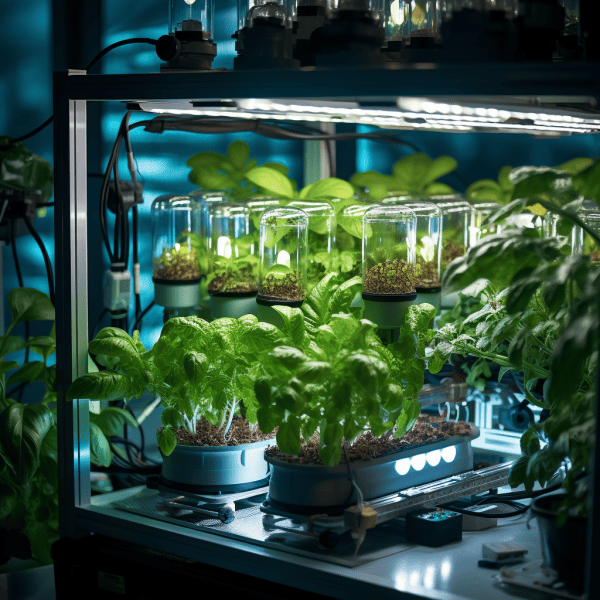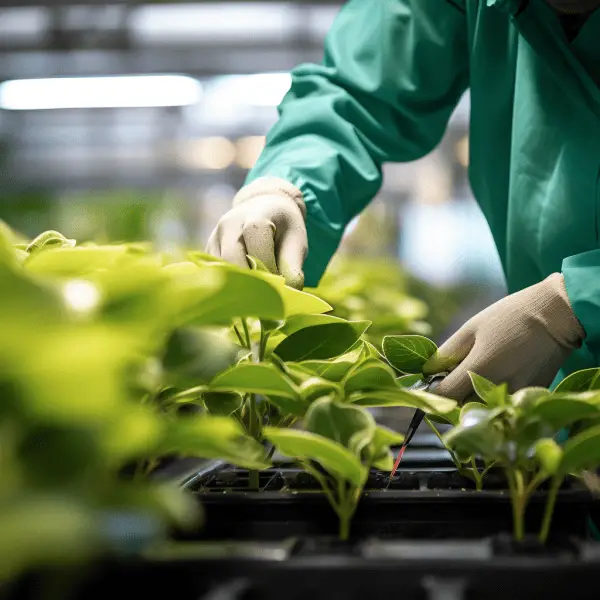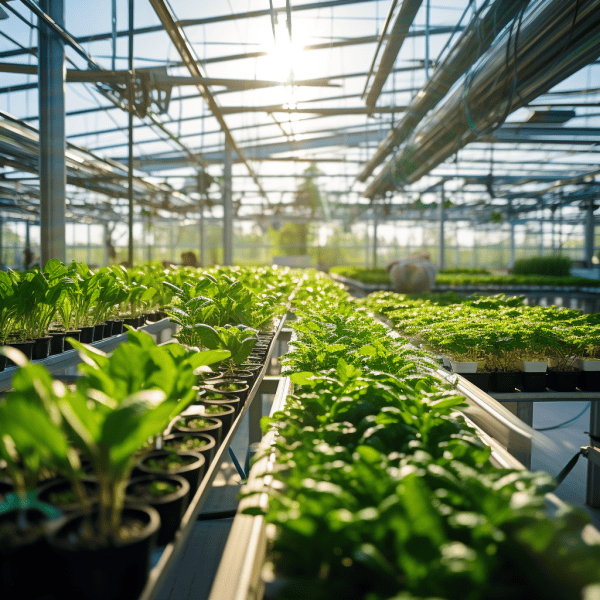Maintaining temperature and humidity is super important in hydroponics.
I learned this the hard way when I first started growing veggies without soil.
My lettuce got too warm and started to wilt.
The humidity in my little indoor greenhouse dropped way too low.
My poor tomatoes looked sad and dry.
After doing more research, I realized I needed to pay more attention to the temperature and humidity for healthy hydroponic plants.
Here are some tips I picked up that really helped me get it right.
First, get a thermometer and hygrometer to monitor the conditions.
Aim for 18-24°C (64-75°F) and 40-60% humidity.
If it’s too hot, use fans, misters, or air conditioning to cool it down.
Add a humidifier if the air is too dry.
Insulate the growing area to keep conditions stable.
Following these steps let me grow the best hydroponic vegetables ever! Keep reading to get all the details for maintaining the ideal temperature and humidity.
Your plants will thank you!
KEY TAKEAWAY
Maintaining temperature and humidity in hydroponics, what should you know?
Maintaining temperature and humidity in hydroponics (1) is crucial for the successful growth of plants.
By carefully controlling these factors, growers can optimize plant health, nutrient absorption, and overall crop yields.
Understanding Ideal Temperature and Humidity in Hydroponics
Growing plants without soil in hydroponics sounds so cool! But it can go south real quick if you don’t get the temperature and humidity right.
As a new hydroponics hobbyist, I learned the hard way that these two factors are super important.
Ideal temperature for most veggies is 18-24°C (64-75°F).
Lettuce and other leafy greens like it on the cooler end, around 18°C (64°F).
Fruiting plants like tomatoes need warmer temps around 24°C (75°F) to thrive.
Proper humidity for hydroponics is 40-60%.
Less than 40% is too dry and over 60% gets moldy.
I messed up by not monitoring temperature and humidity closely those first few weeks.
My little indoor garden felt nice to me, but it was way too hot and dry for the plants.
My poor lettuce wilted and the tomatoes dropped their flowers.
Now I know to use a thermometer and hygrometer to keep an eye on conditions.
I try to maintain 20-22°C (68-72°F) and 50% humidity in my small hydroponic setup.
Keeping the temperature and humidity in the ideal range takes some work, but it’s worth it for healthy, happy plants!
Identifying and Monitoring Current Humidity Levels

The first step to balancing humidity is knowing your current levels.
You’ll need a hydroponic tool as hygrometer to measure the relative humidity in your hydroponic garden.
I like using digital hygrometers since they give constant readings.
Place the hygrometer at plant level in the center of your growing area.
Take readings 2-3 times a day to get a sense of the range.
Humidity fluctuates daily with evaporation, ventilation, etc.
It’s good to track patterns over time.
Record the highs and lows each day.
Compare to the ideal 40-60% range for hydroponics.
If humidity goes above 70% or below 30% regularly, you need to make adjustments.
Consistent levels above 60% increase the risk of diseases like powdery mildew.
Below 40% stresses plants and causes slower growth.
Pay extra attention during times of high evaporation like hot, sunny afternoons.
Humidity crashes can happen fast! With routine monitoring, you’ll catch issues early before they damage your plants.
Signs of Improper Humidity and its Impact on Plants

Plants show clear symptoms when humidity is too high or too low (2).
Leaves are the first indicator.
When humidity is too low, leaves curl and get crispy edges.
They may turn yellow or brown between the veins.
Growth slows as plants conserve energy.
With prolonged high humidity, leaves and stems develop white, powdery mildew.
Buds and flowers rot.
Leaves drop easily.
High humidity provides ideal conditions for fungal diseases.
Root health also suffers without proper humidity levels.
Low humidity dries out roots, inhibiting their growth.
Dark, moist conditions from excessive humidity cause root rot.
If caught early, adjusting humidity helps plants bounce back.
But long-term stress weakens the whole plant.
Monitoring conditions prevents gradual decline.
Your plants will thank you for keeping their environment at that sweet spot of 40-60% humidity.
Choosing the Right Dehumidifier for Hydroponic Setups
If humidity is consistently above 60%, a dehumidifier can lower levels.
Choose a dehumidifier sized for your grow space.
Calculate the square footage and height to determine capacity needed.
For small spaces under 200 square feet, a 25-45 pint dehumidifier is usually sufficient.
Go up to 50-70 pints for 200-500 square feet.
Larger grow rooms need 70+ pint machines.
Portable or floor models work well for hydroponics.
Look for dehumidifiers with continuous drainage hoses so you don’t have to empty buckets.
Continuous operation prevents swings.
Get an Energy Star rated dehumidifier to save on electricity costs.
Models with humidistats automatically turn on and off to maintain a set humidity level.
This takes the guesswork out of operation.
Place the dehumidifier outside the immediate grow area so dry air isn’t blown directly on plants.
Use extension tubing if needed to drain away from the root zone.
A dehumidifier prevents fungal diseases by keeping humidity in check.
Strategies for Balancing Grow Room Humidity
A multifaceted approach works best for controlling humidity in hydroponics.
Start with good airflow from circulating fans.
Fans strengthen plants by simulating wind.
They also evaporate standing water that boosts humidity.
Opening vents or running exhaust fans periodically exchanges humid air for dry air.
But don’t over-ventilate plants that prefer higher humidity like cut flowers.
Group plants with similar humidity needs together.
Dedicate different zones if some crops thrive in drier air.
Position humidifier/dehumidifiers accordingly.
Insulate to stabilize humidity levels.
Plastic sheeting on walls retains moisture.
Insulation also prevents moisture migration into the grow room from outside.
Finally, monitor conditions and tweak as needed.
Increase ventilation or add a dehumidifier if humidity creeps up.
Use a humidifier during dry periods to prevent plant stress.
Stay vigilant!
Effective Techniques for Increasing Humidity
When humidity dips below 40%, hydroponic plants need a boost.
Simple fixes like misting or placing water trays nearby help slightly.
But for significant increases, use a humidifier designed for grow rooms.
Ultrasonic humidifiers generate cool mist from vibrating metal diaphragms.
They rapidly evaporate to raise humidity levels.
Warm mist models boil water, which aids absorption but can heat your space.
Humidistats automatically maintain a set humidity range so you don’t have to babysit the equipment.
Look for large capacity tanks that run longer between refills.
Situate humidifiers upwind from plants so moisture is evenly distributed.
Direct the mist above the canopy using a narrow nozzle.
This prevents wet foliage which encourages diseases.
Handheld spray bottles also work for localized humidity control.
I mist my seedlings a few times a day to keep their microclimate humidified until roots develop.
Remember, too much humidity causes issues too.
Dehumidify if condensation forms on walls, ceilings or plants.
Aim for 40-60% relative humidity for healthy hydroponic crops.
Practical Solutions for Decreasing Humidity
Aside from dehumidifiers, simple solutions can lower excessive humidity in home hydroponics.
First, ventilate to exchange moist indoor air with dry outdoor air.
Open windows or use exhaust fans to create airflow.
Circulating fans also decrease stuffiness.
Run fans continuously rather than only when lights are on.
Fans work triple duty by strengthening plants and distributing CO2.
Insulate cooling ductwork to prevent moisture condensation that drives up humidity.
Ensure HVAC equipment is properly sized for your grow space and not short-cycling.
Group high humidity loving plants away from those that prefer it dry.
Zone your reservoir or nutrient tanks accordingly.
Keep humidifier equipment dialed in to avoid overshooting your target.
Schedule irrigation for mornings so plants dry out during the day.
Allow drainage trays to evaporate completely before re-filling to reset humidity.
A little diligence goes a long way!
Climate Control Automation and Expert Advice for Hydroponics
Maintaining ideal temperature and humidity in hydroponics takes diligence.
Automated systems remove some of the work once conditions are dialed in.
Hygrotherm controllers integrate humidistats and thermostats to control equipment.
They’re programmable to ramp up or down at set times.
This creates a stable growing environment.
Multi-zone controllers can operate different equipment in separate grow rooms.
Zoning allows custom conditions for various crops.
It prevents fighting between cooling fans and humidifiers.
Getting professional advice can also help beginners balance their hydroponic climate.
Most hydroponics stores offer free consultations.
They can inspect your setup and make equipment recommendations.
There are also apps to monitor and advise on conditions remotely.
Busy growers can check phones instead of taking daily readings.
Apps identify issues and suggest solutions to stabilize temperature and humidity.
Automated systems and expert input make maintaining ideal growing conditions much easier.
Focus on your plants while technology and specialists handle the environment!
Consistent temperature and humidity is achievable for hydroponic gardens of every size.
Conclusion
I hope these temperature and humidity monitoring tips help you grow happy hydroponic plants! Monitor conditions closely, especially at first.
Make adjustments as needed to keep your crops in the optimal range.
It takes some work but it’s so worth it for healthy, productive plants.
Let me know how it goes! Share your experiences in the comments or on my social media.
Check out my other articles for more hydroponics advice.
Growing without soil is really rewarding when you get the conditions just right.
Don’t give up – you can do it! With the right temperature and humidity, you’ll be harvesting hydroponic veggies in no time.
References
- https://www.advancednutrients.com/articles/grow-room-temperature-humidity/#:~:text=The%20temperature%20should%20be%20between,difference%20of%2010%C2%BAC%20is%20ideal.
- https://hydrobuilder.com/learn/low-humidity-in-plants/
Related Articles
- https://tophydroponicgarden.com/temperature-and-humidity-monitor/
- https://tophydroponicgarden.com/hydroponic-tools/
Was this helpful?

Crystal Erickson is an agriculture enthusiast and writer with a passion for sustainable farming practices and community development. Growing up on a family farm in rural Iowa, Crystal developed a love for the land and a deep appreciation for the hard work and dedication required to make a farm successful.
After completing a degree in Agriculture and Environmental Science from Iowa State University, Crystal began her career as an agricultural journalist, covering stories and issues related to modern farming practices, crop management, and livestock production. She quickly established herself as a respected voice in the industry, known for her insightful reporting and thoughtful analysis.
Over the years, Crystal has written for a variety of publications, including Farm Journal, Successful Farming, and Modern Farmer, as well as contributing to several academic journals focused on sustainable agriculture and community development. Her work has been recognized with numerous awards, including the Iowa Farm Bureau’s Young Farmer Achievement Award and the National Association of Farm Broadcasting’s Farm Broadcaster of the Year.


